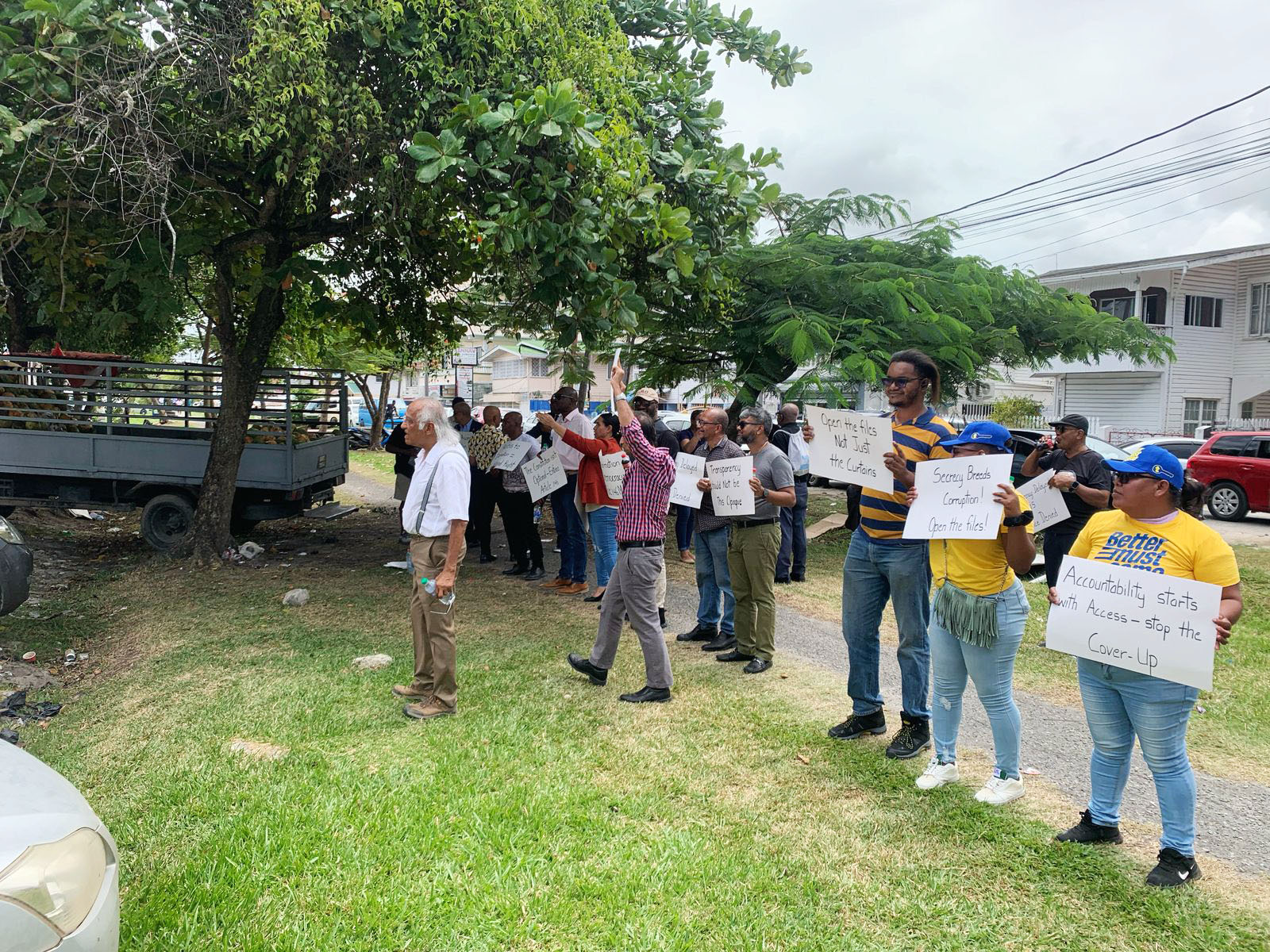Every Man, Woman and Child in Guyana Must Become Oil-Minded – Part 108 – April 9, 2023
Introduction
Part 107 of this column took up the issue of the construction of a Head Office building by Esso Exploration and Production Guyana Limited at Ogle, ECD and asserted that the whole saga is rife with misrepresentation, secrecy, complicity, abuse of power, possible illegality, and a touch of mystery. At issue is the signing of a binding MOU with Ogle Airport Inc. (OAI) for the lease to ESSO of ten acres of land for thirty years, negotiated with Exxon, Esso’s ultimate parent. The only hiccup was that the land was owned by the state under a lease still ten years away from expiry.
OAI’s initial attempt at resolving the problem was to approach Mr. David Patterson, Minister of Public Infrastructure. He demurred. Enter Mr. Fix-It, Joseph Harmon, Minister of State who pushed Patterson aside, replacing and issuing a new Lease to OAI, in one of the most sordid abuses of power by the APNU+AFC Coalition. The role of OAI’s chairman and former Private Sector Commission Chairman Michael Correia might not be as decisive or compelling as Exxon’s or Harmon’s, but it was clearly significant.
Ogle Airport- An Overview
Part 107 traced the development of OAI and how the Correia group came to be in control of the country’s second largest airport, a position which it has monetised to such an extent that it has now become the centre of the Correia’s economic empire. While OAI can hardly be considered a financial success, the Correia group, through four of its companies, reports revenue from their operations that dwarfs the revenue of OAI. The four known Correia companies operating at Ogle report revenue of $7,478 Mn. compared with $379 Mn. earned by OAI. Put starkly, for every $1 of revenue earned by OAI, the Correia Group earns $20. Two of these companies, Correia Mining Company Limited and Caribbean Aviation Maintenance Services Limited, engage in major fuel trading activities at Ogle from which they derive a substantial share of the group’s income. This brings into question whether the Airport is being operated in a manner envisaged in the head lease or primarily for the economic interest of members of the Correia family spread across Guyana, Barbados, USA and Canada.
The original head lease between OAI and the Government provided for an Airport Review Panel which should have met regularly in the first two years and half-yearly thereafter. It appears never to have met while OAI has failed to provide for a Capital Replacement Reserve Fund. (See 4.8 of 2001 Agreement) Sadly, our country’s culture of accountability, transparency and oversight is scanty and it is unlikely that anything will change at Ogle. Like with so many other state assets, the citizenry are seldom the beneficiaries.
Ogle and Exxon
In his letter bearing the same date as the MOU – 27 July 2017, Michael Correia, apparently oblivious of the duration of its main lease, sought Patterson’s “no objection” for a 30-year lease of non-airside property within the Airport. That letter was quite revealing. It advised Patterson that Exxon had indicated to the airport a desire to operate flights directly from Trinidad, Barbados or Suriname as well as “potential future direct operations from the USA.” It also noted that Exxon had identified the airport as an ideal location to establish its main administrative offices, hence the Memorandum of Understanding. And this is where MP Mahipaul’s question (see Part 104 of this Column) about the recoverability of the cost for construction of the Head Office assumes relevance. Here we have Michael Correia’s letter in conflict with the official position of Esso!
Part 104 of this Column quoted ExxonMobil’s Country Manager Alistair Routledge as stating that “the cost recovery mechanism had been cleared by both the previous and the current administrations”. The question is not whether the cost recovery mechanism was cleared but whether it was legally done. And if it was so clearcut and simple, why did it need two different Ministers to grant the approval. Further questions include whether this clearance was applied for in writing and whether the minister, whoever he was/is, sought legal advice on the request and whether the clearance was given in writing.
I am not aware of any authoritative Oil and Gas texts which consider the administrative function as constituting petroleum operations. But any discretionary power vested in the minister responsible for petroleum can be used only in petroleum operations. Also of concern is the use of the ten-acre land for the operation of aircraft by Exxon and its subsidiary, and of course the attendant security implications. What seems to be the case is that Exxon was more open to OAI’s chairman, who thereafter played the role of Exxon’s representative, than they were to the Government.
And there lies the other question. No doubt for self-serving reasons, Exxon chose the branch method of operation in Guyana, giving itself immense latitude in accounting and disclosure. But perhaps the only downside is the requirement set out in section 333 of the Companies Act which provides that any such operation shall “have the power to hold land in Guyana as may be authorised by licence of the President.” Would Routledge care to tell Guyanese which of the Presidents issued such a licence.
Bad signs
To describe the saga surrounding the approval of the cost of Exxon’s head office as recoverable, the basis and authority for the lease to Exxon, the role of Joseph Harmon, and the operation of the Ogle Airport as messy is an understatement. Ramon Gaskin once famously said, in relation to the transfer of public assets into private hands, that Guyana has had oligarchs long before Russia did.
The conception, and the redirection of the use of the Ogle Airport formerly owned by GuySuCo, has transformed a public facility into a private good. Joseph Harmon’s abuse of powers which he never had, and his collusion with OAI to extend their still-to-be expired lease shows the danger of unfettered powers of politicians over state assets. These dangers and their abuse are not peculiar to one party.
The 2016 PSA, signed by the APNU+AFC in 2016 has been embraced by the PPP/C, which now encourages its supporters to move on. The Ogle Airport lease was signed by the PPP/C, improved by the PPP/C, and done whatever by Joseph Harmon. Both these matters cry out for a thorough investigation, if only to prevent a repetition. Disappointingly, the PPP/C has shown an unwillingness to share information on the 2016 Agreement and is unlikely to review Harmon’s railroading of the pro-Exxon extension of the OAI agreement.
Conclusion
For the next thirty years or more, Ogle Airport, now Eugene F. Correia Airport, a public facility, will be operated mainly for the benefit of a few private sector operators led by the Correia’s, and now Exxon. Exxon was quick to react to Mahipaul’s question on the issue of the recoverability of the building cost as a recoverable cost under the agreement. On the other hand, it has been silent on whether Exxon is properly authorised to hold land in Guyana.
Unless Guyana gets modern petroleum legislation under the supervision and administration of an independent Petroleum Commission, our country will continue to lose out on its fair share of petroleum revenue. Sadly, that does not appear on the horizon. Next column: The 2023 Model Petroleum Agreements.
Link to original article: https://www.chrisram.net/?p=2352











